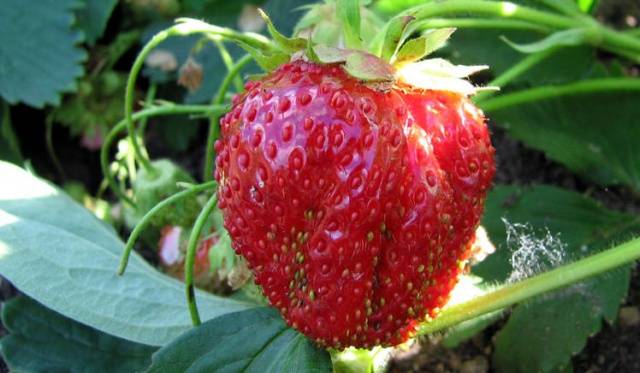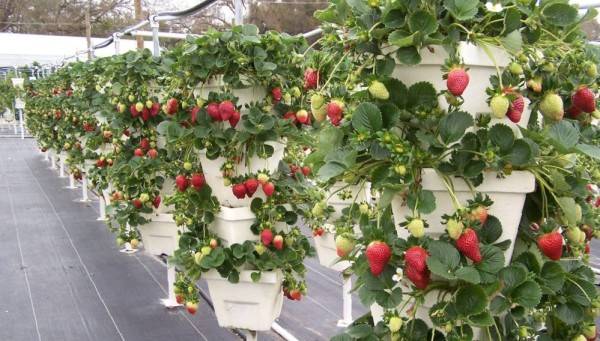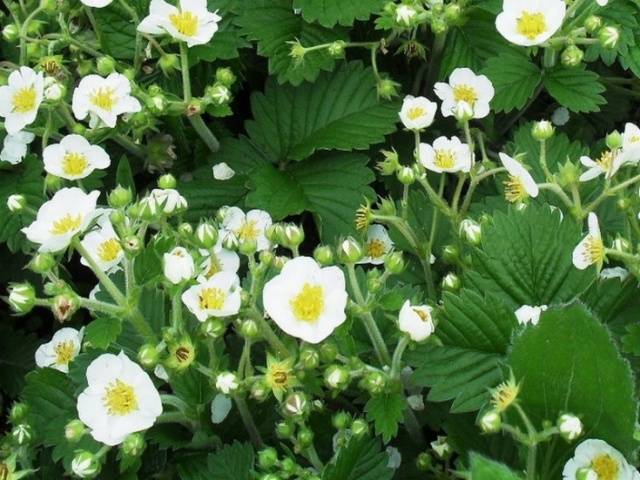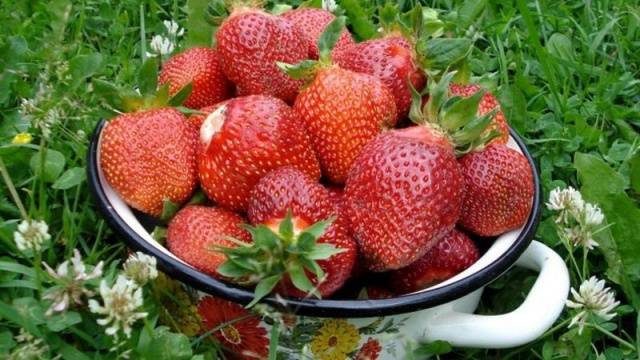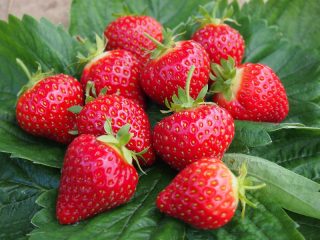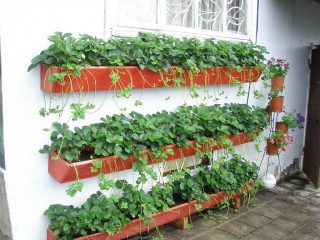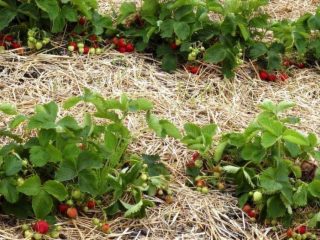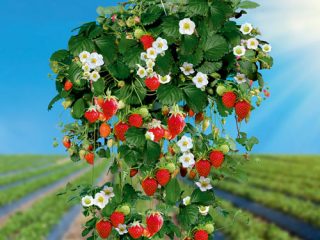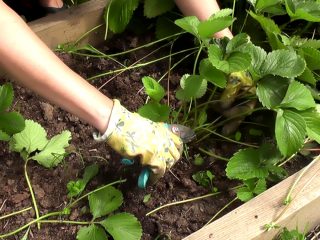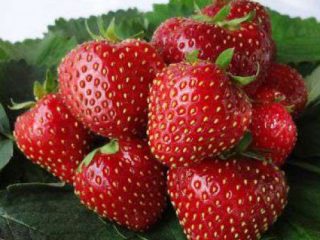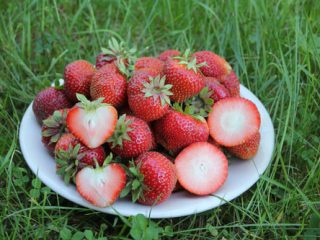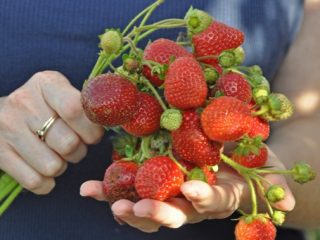Strawberry Ruby Pendant was bred at the All-Russian Research Institute of Genetics and Selection of Fruit Plants from very well-known and time-tested varieties Zenga Zengana and Fairfax. It was included in the State Register in 1998. The variety has many advantages and almost no disadvantages, therefore it is becoming increasingly popular among Russian gardeners. Learn about the Ruby Pendant strawberry variety, its characteristics and cultivation techniques.
Description
The Ruby Pendant variety is mid-season, demonstrates relative resistance to diseases and yields above average.
Description of strawberry variety Ruby pendant and its photo:
- bush of medium height, semi-spreading type;
- roots are powerful;
- leaf in moderation;
- peduncles are umbrella-shaped, located below the leaf blades;
- large mustache;
- berry of medium size and weight (10-20 g), neat, classic cone-shaped with a short neck;
- the pulp is dark red, dense;
- the skin is also dark red, burgundy, shiny;
- seeds in small quantities, moderately pressed into the pulp;
- the taste is excellent, sweet;
- pleasant characteristic aroma.
The berries of the Ruby pendant ripen quite smoothly, come off without effort, and do not wrinkle. Thanks to their dense pulp, they are suitable for transportation and processing.They can be preserved: in compote or jam they do not boil over or lose their shape, and when frozen they do not lose their taste. The yield of the variety is average - slightly above 0.5 kg per bush. Of course, the variety with such productivity is not suitable for growing for sale, but for home use it is quite suitable.
Landing
According to reviews from gardeners about the Ruby Pendant strawberry, it prefers well-fertilized, slightly acidic and neutral soils. Her bush is quite large, so the plants need to be planted so that they have enough feeding area. When planting, you need to maintain a distance of 35-40 cm between the bushes, a little more is possible.
After all the seedlings are planted, the ground around them needs to be mulched with vegetable covering material or dense black agrofibre. The benefits of mulching double – they will not grow under the protective layer weeds, that is, weeding is no longer necessary. This not only saves the gardener’s time and labor, but also allows you not to disturb or injure the plants again. There is no need to loosen the soil every time after watering, since the soil under the mulch is not compacted. And one more advantage of growing strawberries in mulched beds, especially when using synthetic material, is that the berries always remain clean after the rain and are not splashed with dirt. What a ruby pendant strawberry grown under agrofibre looks like can be seen in the photo.
The only drawback of agrofibre is that the plants will have to be watered more often than usual, because rainwater does not get under it. In this case, for convenience, it is better to equip the beds with drip irrigation so as not to worry about the plants lacking moisture.
If you need to save garden space, you can plant strawberries in plastic pipes, large flower pots, or car tires stacked on top of each other. The advantages of this method of growing: it is easier to care for bushes in vertical beds, harvesting is also easier, they can be installed anywhere on the site, for example, near the house, where they will also serve as a kind of decoration.
Growing
For growth and fruiting, strawberries need all the basic elements, but mainly potassium and phosphorus, nitrogen - only at the initial stage of growth. Therefore, it is possible to fertilize plants with nitrogen-containing fertilizers only in early spring, when they begin the growing season. At this time, the most suitable fertilizer will be organic matter - well-rotted compost or humus. It is better not to use fresh manure and mineral fertilizers, as they immediately cause strawberries to increase green mass to the detriment of flowering and fruiting. After the first fertilizing during the season, there is no need to use any more nitrogen. An excellent fertilizer for strawberries would be ordinary wood ash, which contains exactly the elements it needs - potassium and phosphorus, as well as microelements.
Fertilizer application times:
- 1st feeding - in early spring, when the snow melts and it starts to get warmer;
- 2nd – after the first harvest of berries, so that the strawberries can form flower buds for the future harvest;
- 3rd - after collecting the second wave of berries to prepare the bushes for winter.
During autumn feeding, you need to provide strawberries with both phosphorus-potassium and nitrogen fertilizers, so you can use manure and ash. This is especially important for young plants planted this year.
Growing mustaches must be removed in time, leaving only the largest ones, which will be used for reproduction. The rest should be pinched, not allowing them to grow and take root. There is no need to feel sorry for them, they won’t make good strawberries, but they will draw food for themselves, which, of course, will affect the yield.
The Ruby Pendant bears fruit until late autumn. The first harvest ripens at the same time as the harvest of other mid-season varieties, the second - in the fall and continues until frost. It is best to pick berries when they are fully ripe – then they acquire a rich taste and strong aroma.
You need to keep strawberries in one bed for no more than 3-4 years, especially remontant ones, to which the Ruby Pendant belongs. If you leave the plants in their old place, you can expect the berries to become crushed and the yield to decrease. This is why you need to transplant your mustache to a new area. They should be taken only from healthy and strong bushes that show excellent productivity. It is better to replant the mustaches at the beginning of autumn, and not in the spring - by winter they will have time to take root, begin to grow with the onset of warmth, and will be able to make the most of winter-spring moisture reserves, so it will be possible to get a harvest this year.
In the fall, after fruiting has completed, all the bushes of this strawberry must be prepared for wintering:
- Trim off all the old leaves, leaving the youngest ones.
- Burn the waste or put it in a compost heap.
- After about 1-1.5 weeks, the bushes need to be fed.
Then the plants must be covered to protect them from the winter cold. You can use hay, straw, sawdust, dry leaves, spruce branches. The layer of covering material should be quite dense, but not excessively so that air can penetrate to the plants.
Protection from diseases
According to the description, strawberries of the Ruby Pendant variety are unpretentious to growing conditions and are quite resistant to various diseases, but in rainy and cool years they can be affected by gray rot and powdery mildew. Both diseases affect leaves, inflorescences and fruits in varying degrees of ripeness.
To prevent a decrease in yield, or even the death of plants, they must be treated with Bordeaux mixture or copper-containing preparations for preventive purposes. Spraying is carried out 2 times - before flowering and after fruiting.
Another fungal disease that affects Ruby Pendant strawberries is Verticillium wilt. Most often it occurs on clay soils and when crop rotation rules are not followed. For example, this disease can affect bushes growing in an area where nightshades, cucumbers, pumpkins and melons, blackberries, chrysanthemums and roses were previously grown. Control measures: treatment of plants and soil with Bordeaux mixture or fungicidal preparations.
Reviews and videos
Reviews left by gardeners about the Ruby Pendant strawberry variety show that it is in good demand among many of them.
Conclusion
Strawberry Ruby pendant is a real find for a gardener. It can be recommended for cultivation to anyone who wants to get a harvest of vitamin-rich and wonderfully tasty berries on their acres.
